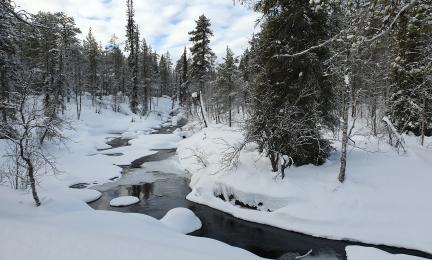New report calls for stronger inclusion of Indigenous Peoples in Arctic forest governance

In the global biodiversity policy targets agreed upon in the UN, conservation and restoration are closely linked to respecting the rights of Indigenous Peoples, customary land use, and Indigenous Knowledge. However, there can sometimes be a long way from policy goals to their implementation.
The Indigenous Knowledge and Arctic Forests (IKForest) project analysed against the targets of the Kunming-Montreal Global Biodiversity Framework, how Indigenous Peoples participate in forest conservation and restoration in Sápmi in Finland, Sweden, and Norway, as well as in the Arctic regions of Canada and Alaska in the United States.
The report to be published at a webinar on 11 December presents good practices and concrete examples of co-management and Indigenous-led restoration, and offers recommendations for policymakers, private actors, and Indigenous organizations.
The report examines four case studies from different parts of the Arctic region: the Laponia World Heritage Site in Sweden; voluntary forest conservation initiatives by Luonnonperintösäätiö and the Snowchange Cooperative in Finland; Torngat Mountains National Park in Canada; and the Hoonah Native Forest Partnership in Alaska. The case studies illustrate how Indigenous-led forest conservation and restoration often combine broad social and ecological goals, where conservation safeguards not only nature but also cultural continuity.
The results show that while the role and knowledge systems of Indigenous Peoples are increasingly recognised in international and national policy frameworks, their participation in forest conservation and restoration remains limited in practice. Participation is often formal rather than substantive, and decision-making has not been based on co-governance or on the principle of free, prior, and informed consent. Similar structural barriers were identified across the entire study area.
The project’s recommendations highlight the need to strengthen Indigenous decision-making power and co-governance, to protect and apply traditional knowledge on Indigenous terms, and to secure sustainable financing and capacity-building.
The project’s report will be published in an open webinar on 11 December from 14:00 to 15:15 (Helsinki time, EET) / 12 to 1:15 pm (GMT). The report’s authors, Inka Musta and Aslak Holmberg, will present the key findings and policy recommendations of the project, and the event will include commentary from representatives of Arctic states, Indigenous Peoples’ organizations, and NGOs.
The webinar will be held in English. Please register here (webropolsurveys.com) by 9 December.
More information:
Project website (syke.fi)
On the project in general:
Aino Lipsanen
Project manager
Finnish Environment Institute
t. +358 29 525 1279
Lotta Manninen
Senior Ministerial Advisor
Ministry of the Environment of Finland
t. +358 295 250 226
forename.surname(at)gov.fi
On the webinar:
Anna Ott
Researcher
Finnish Environment Institute
t. +358 295 252 202
forename.surname(at)syke.fi
On the report:
Inka Musta
Co-author of the report, CEO
Luontoa Ltd.
t. +358 40 634 9900
inka(at)luontoaconsulting.fi